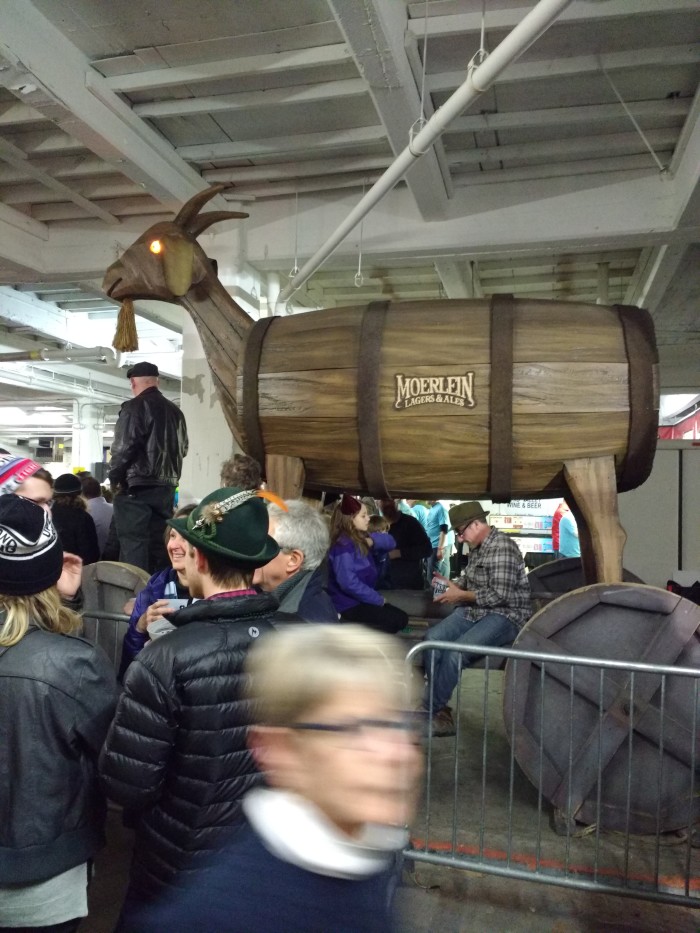Cincinnati Bockfest: A Great Place To Figure Out What A Bock Is
Of all the different types of beer advertising I've come across, one in particular never fails to give me the willies:
Consumers of bock beer have always seemed to be presented as: Adventurous! Strong! Exceedingly attractive to human females! You too can be the successful goat you've always dreamed of becoming — all you need to do is drink more bock. Consider me sold, though I'm also extremely unsettled. What's with that goat? Weird animal themes aside, I simply needed to learn more about this beer style than its current reputation; I honestly don't see it around much. Why makes it special? Do people seem to dig it, or is it possibly a fringe or even a fading style? Why is it so closely tied to goats?
The timing of my inquiry couldn't be better, with Bockfest, America's oldest and largest celebration of the beer style, taking place last week in Cincinnati, Ohio.
As with many aspects of craft beer, when you try to pin down what a particular style can or can't be, or why, there tends to be a bit of subjective interpretation. In this case, I point to Shiner Bock, brewed by Spoetzle Brewery in Shiner, Texas. While basically accurate, this example doesn't even seem indicative of the beer, let alone a quintessential representation of bock, but in its defense, the category is rather broad. On the Shiner website, it's described as "lightly hopped American-style dark lager." In the Beer Judging Certification Program (BJCP) materials, Shiner Bock is described as an "International Dark Lager." So, okay, in terminology we agree at least on dark lager, but what does that mean? The entry on bock in the Oxford Companion to Beer describes it as "a strong beer with an original gravity above 16 degrees Plato and a typical alcohol content beyond 6.5 percent ABV" and continues with a bit of history: "The style originated in the lower-Saxonian town of Einbeck, Germany, and has many regional and commercial variations."
So it originated in Einbeck and has lots of variants. But why an ABV beyond 6.5 percent? In 1617, a Bavarian version of "Oanpock" was quite the rage during the Christian tradition of Lent, when stronger "liquid bread" drinks were employed to supplement the diets of devout Catholics. Even today, there are bock beers classified as "Weihnachtsbock" (for Christmas) or "Osterbock" (for Easter). Ultimately, stronger versions brewed in springtime were termed "Doppelbock" and some breweries crafted "Maibock," which was typically consumed in May.
We can break down the style's parameters even further thanks to the BJCP's guidelines: pale malty European lager, like Helles Bock; amber malty European lager, like Dunkles Bock; strong European beer, like Doppelbock; and German wheat beer, like Weizenbock. It also turns out the goat connection was actually not quite as fantastical as my mind had conjured up after seeing all those funky old advertisements. Per the BJCP, "bock" means "ram" in German, which is why you'll see the animal used in logos and advertisements. I won't lie: I was a little disappointed that the connection was so straightforward.
Given that such a spectrum of categorization exists for all the sub-types of beer under the "bock" moniker, this is one highly diverse genre with untold treasures in the mix. In other words, prime material for a beer festival.
And so I poured myself into the thick of things at Cincinnati's Bockfest, which just celebrated its 24th year. The event, located in the historic district of Over-the-Rhine, was free to the public. Beers were reasonably priced (about $6 each), and the food was great. Usually, if the ticket and beer prices are reasonable, food is either scarce or expensive. Not so at Bockfest — brats and pretzels galore! There was also a parade with ridiculously inventive (occasionally goat-themed) floats, a gender-neutral Sausage Queen pageant, educational experiences to help you decide what the wide and diverse bock style means to you, live music and plenty of people dressed up like a goat, or a fish, or a monk or whatever! Someone brought a papier-mâché goat head! A few notable brews on tap:
Braxton Brewing Company, Covington, KY
Ignitor (Maibock), 7.2 percent ABV
Ei8ht Ball Brewing Co., Bellevue, KY
Queen (English-style mild ale), 5 percent ABV
Blank Slate Brewing Company, Cincinnati, OH
Tank Bottoms (Weizenbock), 6.5 percent ABV
MadTree Brewing: Cincinnati, OH
Bockaveli (bock), 6.2 percent ABV
Of these, my favorite was the Blank Slate Tank Bottoms Weizenbock. In terms of bocks to try that are more widely distributed, either regionally or nationally, I'd recommend any of the following:
Bell's Brewery, Inc.
Consecrator (Doppelbock)
Southern Tier Brewing Company
Goat Boy (Weizenbock)
Staatliches Hofbräuhaus München
Hofbräu (Maibock)
Rogue Ales & Spirits
Dead Guy Ale (Maibock/Helles Bock)
If you find yourself wanting to dive a bit more into sampling bock-style beers, my first suggestion would be to check out what your local brewery has on tap. Maybe strike up a conversation and inquire whether they've ever brewed any bock styles before, or if they plan to? Need an icebreaker? That old ad should do the trick.



